Growing up in Drayton Valley, Alberta, there were always multiple dogs in our home. I don’t remember a time in my life where we didn’t have at least one dog, sometimes cats, fish, and rabbits as well. My mom was so passionate about dogs – I get my passion for dogs from her.
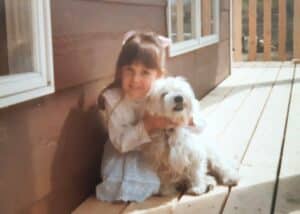
During my University days, I didn’t have a dog, so I would just run around asking everybody that would possibly indulge me, “Can I pet your dog?” That’s how I got my fix of dog love – I’d sometimes call people across the street.
After graduating, I became a professional stage actor, and I needed a side hustle, so I thought becoming a dog trainer would be perfect for me. I loved dogs so much, and if I had to have a side hustle, it made sense to do something I was really interested in, and it would be easy to see clients for lessons in between breaks in my schedule with a lot of flexibility.
I found a professional dog training school located in Saanich, BC, signed up, and packed up and moved to begin my studies.
If This Is Dog Training, No Thanks
We were taught to use food, praise, and toys to teach new behaviours, but we also had choke chains on the dogs and we were taught how to physically punish our dogs when they didn’t do what we wanted. I didn’t know it at the time – but I was learning balanced training methods. Dominance theory was part of the curriculum, and if we allowed them to become more dominant than us, they’d take over.
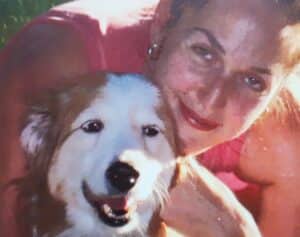
It slowly sucked the life out of me. I went there quite excited to learn about dogs – but every time I had to deliver a correction to my dog, I felt sad, sick, and angry too. I wasn’t even sure who I was angry at. It just brought up really yucky feelings in me, and it was tense and stressful.
Dogs changed too. They started out happy and excited, and over time became less enthusiastic and more withdrawn. Some dogs started lunging and even snapping at their owners.
I worked really hard at the program, despite how I felt. I graduated with really high marks, but left thinking if this is dog training, I don’t want to do it ever again.
A Life Changing Book
Ready to return to Alberta, and never touch dog training again, the strangest thing happened. As we were graduating and leaving, a fellow student shared a book called “Don’t Shoot the Dog” by Karen Pryor with me, and she asked if I ever read it. I hadn’t, but it sounded interesting, so I gave it a read.
The book changed my whole life. It made me feel like the skies opened up. All of a sudden, I was so excited and inspired to train dogs again – I suddenly became aware there were other ways to train dogs that didn’t involve all the corrections and dominance theory. My spark that I lost over the course of the balanced training program was immediately reignited and I began ordering every book on positive reinforcement training I could find. I moved back to Alberta, settling in Calgary, and went to volunteer, and eventually became an instructor at Sit Happens (a positive reinforcement training school) while continuing my acting career.
Oscar, From Perfect Puppy to Aggressive Dog
My partner at the time and I decided it was time to get our first puppy together. I had never raised a puppy as an adult before, and we were excited. We did our research, and found the right breeder, and eventually brought home Oscar, our Vizsla, at 8 weeks old.

During the first year of Oscar’s life, he went through all the socialization and training classes, and did so well at them, he had lots of dog friends at the dog park, he had a great recall. Everything was textbook perfect.
But, at around a year of age, we brought Oscar over to my mom’s home, and while preparing all the dogs’ meals in the kitchen, a big resource guarding fight broke out. I had never seen dogs really fight, and it was one of the scariest things I ever experienced. All the humans in the kitchen (my brother, my dad) jumped in, shouting, to separate them. There was no physical damage, but the emotional damage had been done.
I felt sick – I thought I had done everything right in raising Oscar as the perfect puppy – and if I did everything right, Oscar shouldn’t have behaved this way.
The very next day, I went for a walk, and Oscar got into his first-ever fight at the dog park with a female Cane Corso.
In the coming weeks and months, fights at the park kept on getting more frequent. My partner called me one day and said, “Rachael, we can’t take Oscar to the park anymore. He just beat up a Gordon Setter puppy that was totally minding his own business.”
At this point, I was in a state of deep sadness – real mourning, because I realized the puppy I had worked so hard to raise, socialize, and train couldn’t be around dogs anymore, and I didn’t know what to do about it.
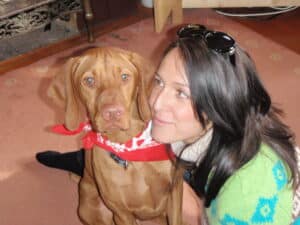
I didn’t give up on Oscar and I decided to keep on learning from anyone who could teach me. My colleagues at Sit Happens helped me get started. I eventually enrolled in the Karen Pryor Academy, and graduated in 2009, to continue to become a better trainer. I drove three hours each way once a week to see a particular trainer who taught me about desensitization and counter-conditioning.
Learning as a Dog Walker
It was around that time, after being a working actor for over a decade, I started to question whether I wanted to continue with acting. I made the decision to move to Toronto, take a step back from acting, and just get a regular job and reflect.
Naturally, I looked for dog related work – and became a part-time instructor at When Hounds Fly, and a full-time dog walker. Becoming a full-time dog walker was such an important part of my development as a dog trainer, and it was life changing.
Being a dog walker for five years, walking two full groups per day, off-leash, taught me an incredible amount about how dogs interact with one another. I learned how to help dogs make good choices when interacting with one another.
When Oscar got into his first fight all those years ago, I thought I might die. I was so terrified. As a dog walker, you learn that dogs get mad at each other sometimes, and it’s not the end of the world. The dogs I walked helped me learn about their needs, their methods of communication, and in turn, I learned how to help them navigate tricky social situations peacefully. It was a team effort.
With this new knowledge, I was able to help Oscar even more. I taught him the engage-disengage exercise, so he was more manageable on-leash, but the challenge was getting him more comfortable in off-leash settings.
A Behavioural Setback and the Catalyst for Recovery
A behavioural setback ended up being the catalyst for a real breakthrough. In his midlife, Oscar developed severe separation anxiety. This meant I couldn’t leave him home alone while I walked dogs. He hadn’t been to an off-leash dog park in years, not since that final incident with the Gordon Setter puppy.
His separation anxiety forced me to take him with me on my group walks. He was a lot less reactive in general at this time, and I was much more skilled at this point, so I took him on group walks, making sure that all the greetings with the other dogs were done carefully so he could get comfortable with each of them.
When we arrived at the off-leash park, I spent extra time helping Oscar acclimate to the environment, so he could integrate and settle in his own time. Naturally, all the methods I used with Oscar were soundly based in positive reinforcement training.
If he ever felt a bit overwhelmed, Oscar could count on me to get him out of a sticky situation. Over time, off-leash group walks with Oscar became a well-orchestrated practice, and a two-way conversation and fluid dance between the two of us. He would tell me when he was having a hard time, and we’d pull back. On good days, we’d explore more together.
Some days, I could tell he was a bit nervous when new dogs approached him. It wasn’t perfect – sometimes he’d snap at them. But this was nothing like before, where the fights looked like Oscar was trying to kill the other dog.
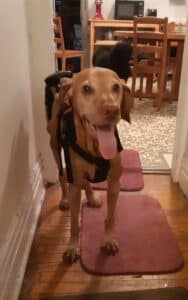
Oscar was changing slowly with every walk, though. Once in a while, I started to notice he’d approach a dog with “interested” body language, the kind that I hadn’t seen since he was a baby approaching with a wiggly tail and bouncy energy. He’d then start playing with them. Seeing that side of him come back after so many years brought me so much joy.
As Oscar improved, I was able to start boarding dogs in my home as well. Oscar started to recognize that having strange dogs in the house was no big deal, and in some rare cases, in his senior years, he would actually start playing with them, just like when he was a puppy. That playfulness fully came back in his final years.
My Greatest Teacher
In the end, this is what I have to say about Oscar. He taught me what it means to really, really, really love a dog. Loving a reactive dog takes a lot of courage, a lot of patience, and a lot of understanding and compassion. But if you are willing to extend that love and take your time with them, the bond that you will forge cannot be expressed in words.
Oscar getting into that fight in my mom’s kitchen was a traumatic incident, but it set me up for a lifetime of learning with Oscar. I feel I have so much to offer to reactive dog parents, not just in terms of technical knowledge and training techniques, but in terms of compassion and understanding. I truly understand what it’s like to be the person holding the leash of a dog that is thrashing around, biting, and trying to fight. It’s a scary place, but you don’t have to stay there forever. The journey out of there is pretty magical, if you’re brave enough to take those steps and start learning and growing.
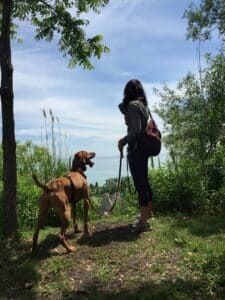
Rachael’s long-term goal of helping more dogs like Oscar is coming to fruition this April, when she will be launching the first round of Reactive Dog Classes at When Hounds Fly’s South Etobicoke location. There, she’ll share what she has learned and help a lot of dogs (and their parents!) on their own road to recovery.
